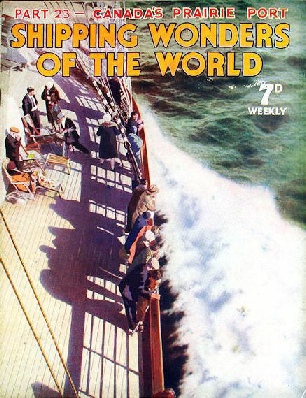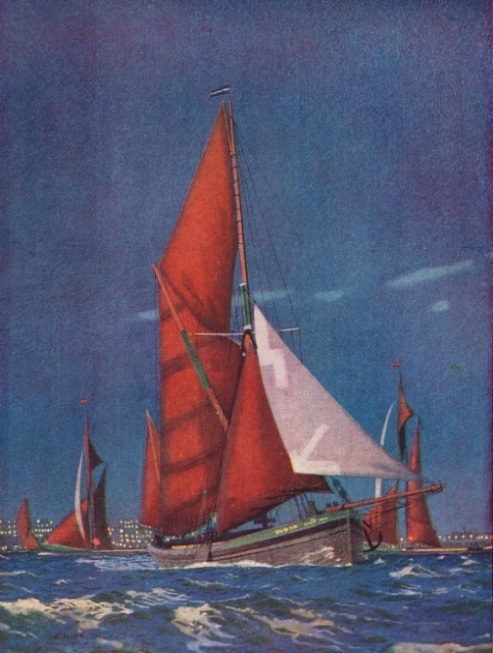
© Shipping Wonders of the World 2012-



Part 23
Part 23 of Shipping Wonders of the World was published on Tuesday 14th July 1936.
This issue included a colour plate illustrating Spritsail Barges on the River Thames by Charles Pears ROI which accompanied an article on Thames Sailing Barges.
The Cover
This week’s cover represents a scene on the deck of the North German Lloyd liner Bremen in mid-ocean. The Bremen temporarily regained the Blue Riband of the Atlantic for Germany in 1929. She is the sister ship of the Europa.
The Bremen also featured on the covers of
part 6, part 11, and part 20.

Contents of Part 23
Captain Slocum the Pioneer
The story of the first man to sail single-handed round the world, concluded from part 22.
Development of the Oil Tanker
Oil and spirit in bulk form the most dangerous cargo that ships have ever carried. Many special construction al devices have been evolved to obviate, as far as possible, the risks entailed by this perilous cargo. There is in existence at present a vast fleet of oil tanker vessels, with a total gross tonnage of over 9,000,000. Before 1914, the total tonnage of oil tankers was rather less than 1,500,000.
This chapter is the third article in the series on the Romance of the Trade Routes.
Navy Week
Every year since 1928 the Royal Navy has admitted the public into the dockyards at Portsmouth, Plymouth and Chatham during Navy Week. Thousands of people are this enabled to see the Navy at work. The institution of Navy Week has been instrumental in enabling us to widen our experience, and the great success of this annual event is a tribute to our ability to answer the call of the sea when the call is sounded. The Navy Week Committee deserves all our congratulations for the work it does.
Compound, Triple and Quadruple Expansion Engines
The final form of the marine reciprocating engine was of the vertical type using steam in two, three or four stages of expansion.
This chapter is the sixth article in the series Marine Engines and Their Story.
Canada’s Prairie Port
When the freighter Pennyworth sailed in 1932 to Churchill, Hudson Bay, she opened up a new commercial route to the prairie provinces of Canada. She was the first vessel to prove that the navigation of these subarctic waters was practicable for freighters. On August 17, 1932, the
SS Pennyworth of Newcastle-on-Tyne, arrived at Churchill with a cargo and passengers - one of the first vessels to reach Canada by this route.
Thames Sailing Barges
The strongly-built and picturesque barges which may be seen on the Rivers Medway and Thames are fine sea-boats and still retain many of the traditional features of the first craft of their type. Although the Thames barges are essentially English craft, they do not confine their activities to the Thames. Many of them sail as far afield as France and Holland. Some years ago tow of them were temporarily rigged as ketches and went out to South America. This chapter tells the history of the barge, discusses its curious rig and describes the famous annual races on the Thames and Medway.
Spritsail Barges on the River Thames (colour plate)
Raising the German Fleet
When the Germans scuttled their interned warships at Scapa Flow, Orkney, in June 1919, most people thought that the ships had found their last resting-place. By a series of salvage miracles many of the seventy-two German vessels have now been raised.
The article is concluded in part 24. This chapter complements that published earlier on the “Surrender of the German Fleet”.
This is the eighth article in the series Dramas of Salvage.
Spritsail Barges on the River Thames
SPRITSAIL BARGES on the River Thames at dusk, from the oil-painting by the famous marine artist Charles Pears ROI. The sails of these Thames barges are a rich warm red in colour, but the lighter sails are white. The hulls are flat-bottomed and the vessels can therefore penetrate shallow creeks and rivers. Thames sailing barges are ordinary workaday vessels but they are astonishingly seaworthy. They are among the most picturesque craft afloat and form a striking contrast to the power-driven vessels which are attempting to oust them from their trades.
